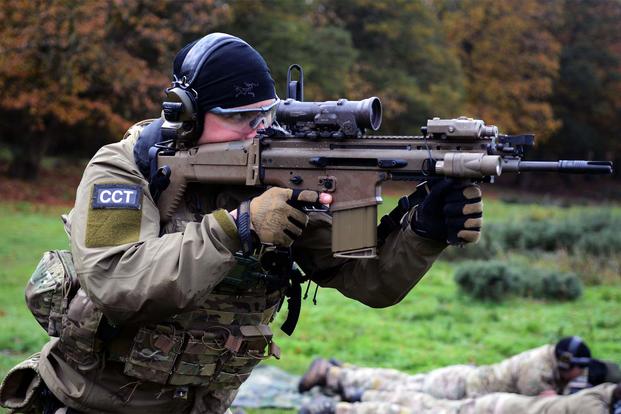U.S. Army weapon officials just opened a competition for a new 7.62mm Interim Service Combat Rifle to arm infantry units with a weapon potent enough to penetrate enemy body armor.
"The Army has identified a potential gap in the capability of ground forces and infantry to penetrate body armor using existing ammunition. To address this operational need, the Army is looking for an Interim Combat Service Rifle (ICSR) that is capable of defeating emerging threats," according to an Aug. 4 solicitation posted on FedBizOpps.gov.
The service plans to initially award up to eight contracts, procuring seven types of weapons from each gunmaker for test and evaluation purposes. Once the review is concluded, the service "may award a single follow-on Federal Acquisition Regulation (FAR) based contract for the production of up to 50,000 weapons," the solicitation states.
Related content:
- Army Chief: Infantry Needs New 7.62mm Rifle
- US Army to Search for New 7.62mm Rifle
- Army to Gunmakers: Show Us a New 7.62mm Service Rifle
"The Government has a requirement to acquire a commercial 7.62mm ICSR to field with the M80A1 Enhanced Performance Round (EPR) to engage and defeat protected and unprotected threats," the solicitation states. "The ultimate objective of the program is to acquire and field a 7.62mm ICSR that will increase soldier lethality."
The opening of the competition comes just over two months after Army's Chief of Staff Gen. Mark Milley revealed to Congress that the M4 Carbine's M855A1 Enhanced Performance Round cannot penetrate modern enemy body armor plates similar to the U.S. military-issue rifle plates such as the Enhanced Small Arms Protective Insert, or ESAPI.
This past spring, Vice Chief of Staff Gen. Daniel Allyn released a directed requirement for a new 7.62mm rifle designed for combat units, prompting Army weapons officials to write a formal requirement.
The presence of a 7.62mm rifle in Army infantry squads is nothing new. Since 2009, the Army's squad designated marksman rifle has been the Enhanced Battle Rifle, or EBR, 14 -- a modernized M14 equipped with a Sage International adjustable aluminum stock with pistol grip, a Leupold 3.5x10 power scope and Harris bipod legs.
The Army adopted the EBR concept, first used in 2004 by Navy SEALs, in response to the growing need of infantry squads operating in Afghanistan to engage enemy fighters at longer ranges.
The EBR is heavy, just under 15 pounds unloaded, compared with the standard M14's unloaded weight of 9 pounds.
The Army's Interim Combat Service Rifle should have either 16-inch or 20-inch barrels, a collapsible buttstock, an extended forward rail and weigh less than 12 pounds unloaded and without an optic, according to a May 31 Army request for information.
Multiple proposals may be submitted by the same organization; however, each proposal must consist of the weapons, proposal, and System Safety Assessment Report. All proposals are due by 3 p.m. Eastern Daylight Time Wednesday Sept. 6 September 2017, the solicitation states.
In addition to the weapons, gun makers will also be evaluated on production capability and proposed price, according to the solicitation.
All weapons should include items such as a suppressor, cleaning, specialized tools and enough magazines to support the basic load of 210 rounds.
The competition will consist of live-fire testing and evaluate the following:
- Dispersion (300m - function, 600m - simulation)
- Compatible with Family of Weapon Sights - Individual and laser
- Weapon length (folder or collapsed)/ Weight (empty/bare) / Velocity (300m and 600m calculated)
- Semi-Automatic and Fully Automatic function testing (bursts and full auto)
- Noise (at shooter's ear) / Flash suppression
- Ambidextrous Controls (in darkness or adverse conditions) / Rail interface
- 20-30 round magazine to support a 210 round combat load
- Folding sights
"Areas to be evaluated could include, but not be limited to: Controllability and Recoil, Trigger, Ease/Speed of Magazine Changes, Sighting System Interface (e.g., ability to acquire and maintain sight picture), and Usability of Controls (e.g., safety)," the solicitation states.
"Additionally, a small, limited user evaluation may be conducted with qualified soldiers," it states.
Milley told lawmakers in late May that the Army does not believe that every soldier needs a 7.62mm rifle. These weapons would be reserved for the Army's most rapid-deployable infantry units.
"We would probably want to field them with a better-grade weapon that can penetrate this body armor," Milley said.
-- Matthew Cox can be reached at matthew.cox@military.com.































